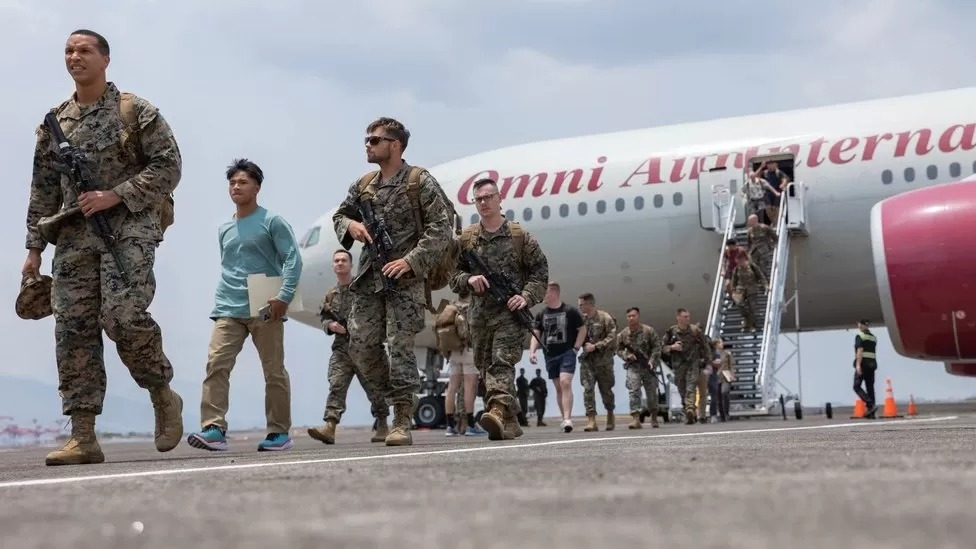US, Philippines begin largest-ever drills after China exercises
11 April, 2023

The US and the Philippines are holding their largest-ever joint military drills a day after China concluded large-scale exercises around Taiwan.
Over three days, China's military rehearsed blockades of Taiwan in response to the island's leader meeting the US House Speaker last week.
Washington criticised China's display of firepower as disproportionate, while Taiwan President Tsai said it was "irresponsible" and she had the right to make visits to the US.
The US drills had been earlier planned.
Filipino and US officials say the drills show their commitment to peace and stability in the Indo-Pacific region that is open and free.
Washington announced last month that their annual Balikatan exercise with the Philippines would be their largest ever - involving more than 17,000 troops, including 12,000 from the US.
The two week Balikatan operation will also see the two militaries execute a drill to blow up a mock target warship in the South China Sea - a move that could incur China's wrath.
In February, Washington secured a new defence deal with Manila where four new naval bases will be established on Philippine islands close to contested waters.
Three of these bases are to the north of Luzon Island, the nearest bit of land to Taiwan besides China.
The waterways around the Philippines and in the South China Sea contain some of the world's most valuable trade routes, and have been the subject of disputed territorial claims by China in recent years. On Monday, as China was concluding its own drills where it deployed fighter jets and an aircraft carrier around Taiwan, the US sent a naval destroyer through the South China Sea in what it called a freedom of navigation mission.
The US sent the USS Milius past the Spratly Islands, which lie in the Philippines' exclusive economic zone but are claimed by Beijing.
That angered Beijing. China on Monday also warned that US-Philippines military cooperation should not interfere with disputes in the hotly contested waters.
"[It] must not interfere in South China Sea disputes, still less harm China's territorial sovereignty, maritime rights and interests and security interests," Chinese foreign ministry spokesman Wang Wenbin said on Monday.
Beijing's drills concluded on Monday. Afterwards, Taiwan's defence ministry said it would keep strengthening its "combat preparedness".
President Tsai in a Facebook post on Monday night also stated she had the right to represent her island on the world stage, and condemned China's military response to her US stopovers as "irresponsible actions of a regional power".
A dozen countries in the region will also participate in the Balikatan exercises, set to run until 26 April. Australia has sent 100 troops.
The focus of the Balikatan drills have evolved in recent years reflecting a shift in geo-security concerns in the region. In the 2000s, it centred on counter terrorism drills after extremist groups affiliated with al-Qaeda carried out bomb attacks in southern Philippines.
However, China's rapid military expansion and claims on territory in the disputed South China Sea, particularly on several Philippine islands, has prompted a wider response.
The Philippines' role in security in the region has grown. Many believe increased US access to Philippine bases could provide launchpads for combat operations in the event of armed clashes over flashpoints like Taiwan or the South China Sea.
Philippine President Ferdinand Marcos Jr reiterated on Monday that the US would not be able to access military sites for offensive moves.
"China's reaction [around Taiwan] is not surprising, since it has its own concerns. But the Philippines will not allow our bases to be used for any offensive actions. This is only meant to help the Philippines should the need arise," he said.
A front row seat to monitor China
The US is seeking access to places where "light and flexible" operations involving supplies and surveillance can be run as and when needed, rather than bases where large numbers of troops will be stationed.
In February, Washington secured access to four additional military bases in the Philippines - a deal that helped the US stitch the gap in the arc of alliances stretching from South Korea and Japan in the north to Australia in the south.
The missing link had been the Philippines, which borders two of the biggest potential flashpoints - Taiwan and the South China Sea.
One of the bases they now have access to faces Taiwan, the second the Scarborough shoal, and the third the Spratly Islands. US troops will come in small groups and on rotation.
The aim, analysts say, will be to deter further territorial expansion by China in the South China Sea, while also providing a place for the US to watch Chinese military movements around Taiwan.
With increasing concern about a conflict over Taiwan, the Philippines could offer a "rear access area" for US military operations, or even a place to evacuate refugees.
Source: www.bbc.com
TAG(s):
